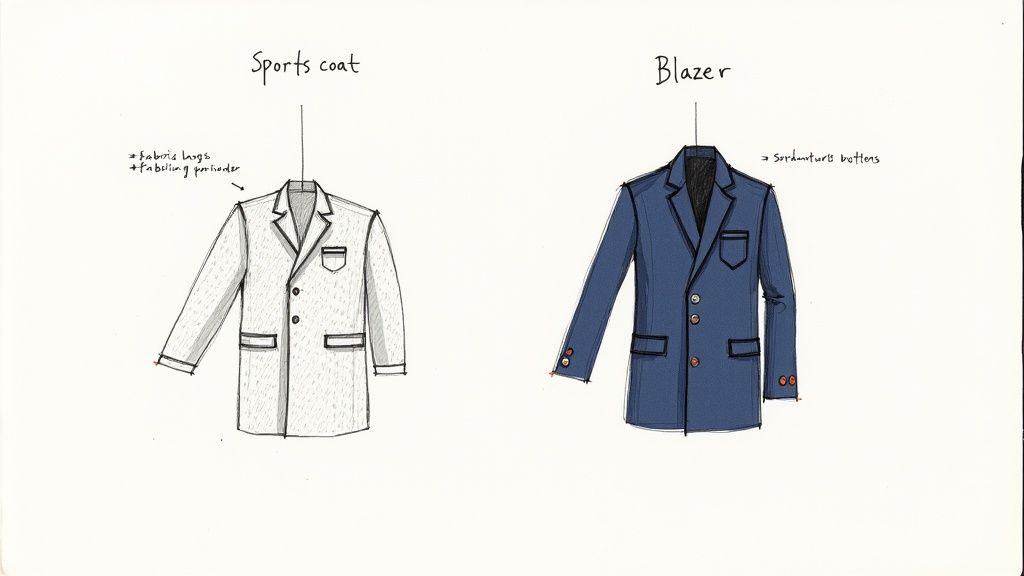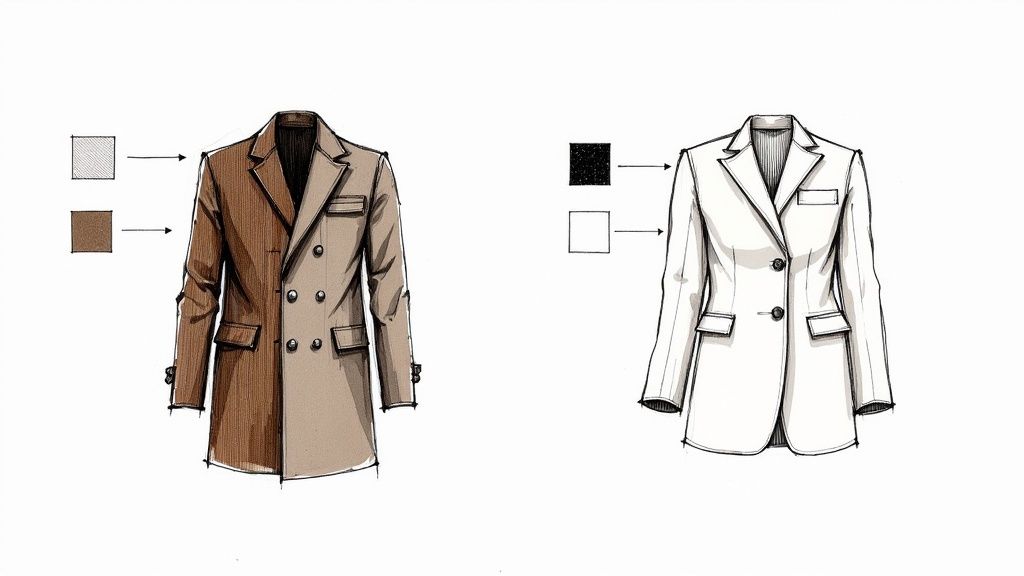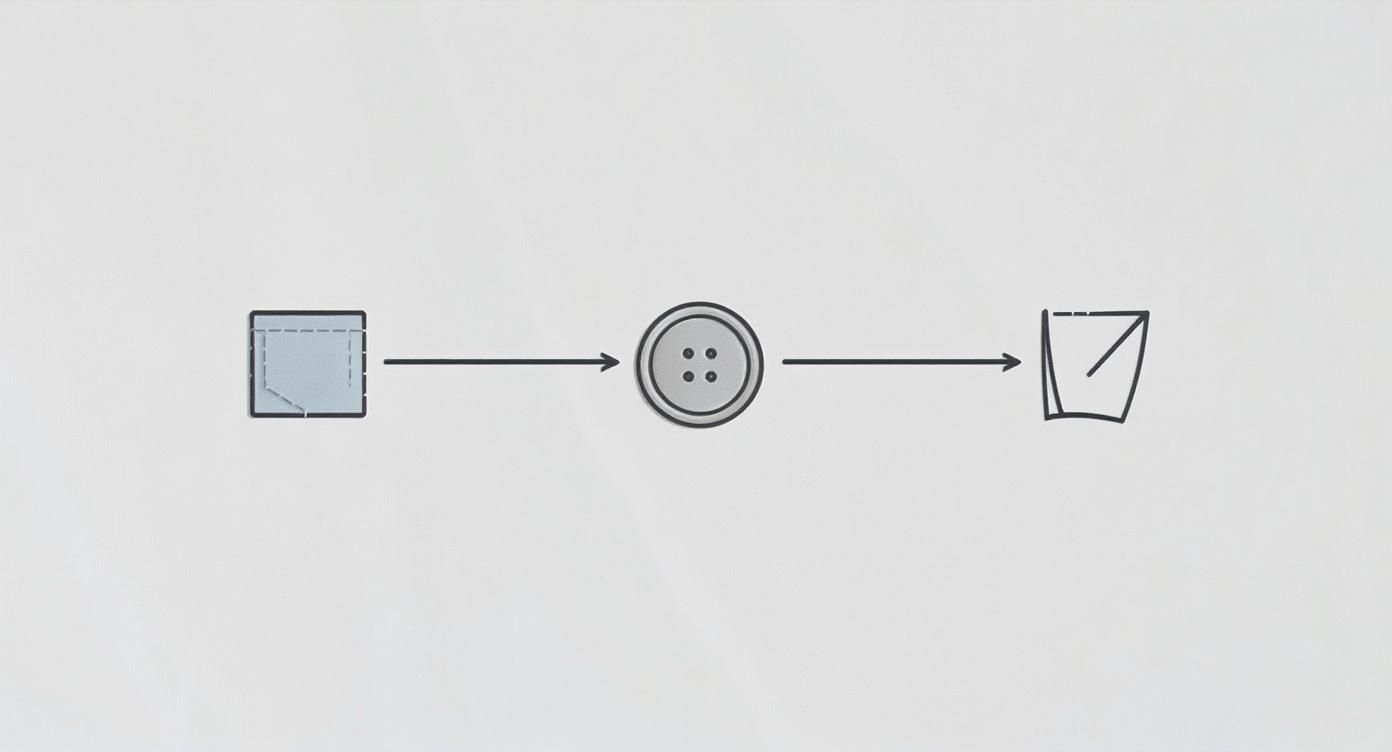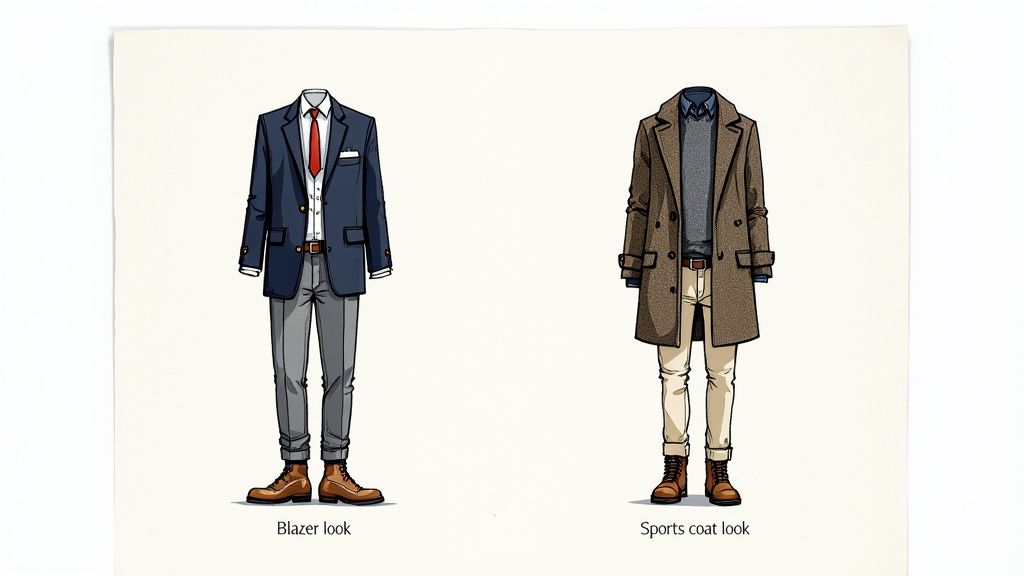Key Takeaways
- Formality & Origin: The primary difference between a sports coat and a blazer is formality, rooted in their origins. Blazers are more formal with naval/club heritage, while sports coats are casual with countryside sporting roots.
- Fabric & Pattern: Blazers are typically made from smooth, solid-coloured fabrics like worsted wool. Sports coats feature textured, patterned fabrics like tweed, herringbone, or corduroy.
- Buttons: A blazer's most defining feature is its buttons, which are usually metal (brass, silver) or mother-of-pearl. Sports coats have more rustic buttons made from horn, leather, or plastic.
- Occasion: Blazers are ideal for business-casual settings, smart dinners, and club events. Sports coats excel in smart-casual and relaxed environments like weekend lunches or creative workplaces.
At their core, the difference between a sports coat and a blazer boils down to formality and heritage. The blazer, with its naval roots, is a more formal, solid-coloured jacket. In contrast, the sports coat began life as a casual, patterned jacket for country sports. Think of it this way: a blazer is structured, often with shiny metal buttons, while a sports coat leans into textured fabrics like tweed with rustic horn or leather buttons.

A Quick Comparison Guide
Choosing between a blazer and a sports coat really depends on the occasion and the impression you want to make. One jacket speaks to a history of uniformed precision, while the other brings to mind a more relaxed, rural heritage. Both are absolute essentials in a gentleman's wardrobe, but knowing when and how to wear each one is the key to impeccable style.
This guide gives you a clear, at-a-glance look at their core differences. And for those looking to perfect the silhouette of either jacket, understanding the distinctions between slim vs tailored fit is an excellent next step.
Sports Coat vs Blazer A Quick Comparison
To simplify things, this table breaks down the essential characteristics of each garment. It’s a straightforward way to see the primary differences at a glance.
| Feature | Sports Coat | Blazer |
|---|---|---|
| Fabric | Textured & patterned (tweed, houndstooth, plaid) | Smooth & solid-coloured (worsted wool, serge) |
| Formality | Casual to smart-casual | Smart-casual to business-casual |
| Buttons | Horn, leather, or plastic | Metal (brass, silver) or mother-of-pearl |
| Origin | 19th-century British country & sporting wear | 19th-century British naval uniforms & rowing clubs |
| Fit | Looser, less structured for layering | More structured and closely fitted |
| Pockets | Often patch or hacking pockets | Typically flap or jetted pockets |
Ultimately, this comparison highlights that while they might seem similar, each jacket carries its own distinct identity. One isn’t better than the other; they simply serve different purposes in building a versatile and stylish wardrobe.
Tracing the Heritage From Countryside to Club
To really get to grips with the difference between a sports coat and a blazer, you have to look at where they came from. Each jacket was created for a specific purpose, and that need shaped its form, fabric, and function from day one. It’s these separate sartorial legacies that still dictate how we wear them today.
The sports coat is pure 19th-century British country life. Gentlemen needed a tough, practical jacket for outdoor pursuits like shooting and hunting. This was never a garment for the city; it was functional outerwear, built to fend off the elements and allow for plenty of movement. Its rustic character is a direct result of its purpose.
The Rugged Sports Coat
This demand for durability led to the use of heavy, textured fabrics. Think of the classics:
- Tweed: Famous for its warmth and resilience against harsh weather.
- Herringbone and Checks: These patterns weren't just for show; they also served as a form of camouflage out in the countryside.
- Corduroy: A tough-as-nails fabric that could handle the rigours of a day outdoors.
These jackets were designed to be thrown over other layers, like a thick knit jumper, which explains their traditionally looser, less structured fit. It's no surprise that when you're looking for the perfect weekend suit, the trail often leads back to these comfortable, versatile origins.
The Distinguished Blazer
The blazer, on the other hand, tells a completely different story—one that begins on the water, not in the fields. Its heritage is tied up with the smart uniforms of the British Royal Navy and the prestigious rowing clubs of universities like Oxford and Cambridge. The most famous origin story credits the captain of HMS Blazer, who, in 1837, had his crew kitted out in dark blue, double-breasted jackets with brass buttons to impress a visiting Queen Victoria.
This maritime and collegiate background cemented the blazer's more formal, structured character. It was designed to signal uniformity, discipline, and status.
The blazer was never intended as rugged outerwear; it was a symbol of belonging to an elite group, which is why it still carries a more polished and authoritative feel.
This history is still incredibly relevant here in the UK. In the British men's apparel market, sports coats are associated with robust, patterned country wear, while blazers are seen as the more formal, solid-coloured jackets with naval roots. You can dig deeper into these market distinctions with Statista's analysis on blazers in the UK. Understanding these separate paths makes it clear why a tweed sports coat feels so at home in a country pub, while a navy blazer commands respect in a city club.
Comparing Fabric Texture and Garment Construction
Setting aside their unique histories, the most immediate, tangible difference between a sports coat and a blazer is in the cloth they’re cut from and how they’re put together. These choices aren't just for show; they’re a direct line back to each jacket's original purpose. Simply touching the fabric and feeling the construction tells you everything you need to know about its story.

A sports coat is instantly recognisable by its hearty, visually interesting fabrics. Born from a need for something rugged in the countryside, its materials are robust and brimming with character. These are jackets that invite you to take a closer look, to appreciate their texture.
The Hearty Weaves of a Sports Coat
The cloths traditionally used for sports coats were chosen for resilience and their rustic feel. They’re designed to be worn, lived in, and layered up comfortably.
- Tweed: The quintessential sports coat fabric, famous for its warmth and its dense, weather-resistant weave. A Harris Tweed, with its iconic Orb mark, is the benchmark for quality.
- Corduroy: Its signature ribbed texture, known as "wales," gives it a soft yet durable finish that straddles the line between casual and smart perfectly.
- Herringbone and Donegals: These patterned wools add real depth and a classic rural charm, making them ideal for creating a sophisticated, layered ensemble.
These textured materials are absolutely central to the sports coat's identity, setting it apart from its smoother relatives at a glance.
The Refined Drape of a Blazer
In sharp contrast, a blazer is cut from smoother, finer cloths that create a much cleaner, more formal silhouette. Its fabrics are selected for their sleek appearance and their ability to hold a crisp line, a nod to its more uniformed and distinguished origins. You’ll typically find them in worsted wool or serge, materials known for their crisp finish and minimal surface texture.
A blazer’s smooth fabric is designed to present a clean, unbroken line, projecting an air of authority and polish. The focus is on the silhouette, not the texture of the cloth itself.
This fundamental difference in fabric directly shapes how each jacket is constructed. The sports coat, built for movement and layering, often has a soft, natural shoulder with very little padding. This creates a relaxed shape that drapes comfortably over a shirt or even a thick jumper.
The blazer, on the other hand, is engineered for a sharper profile. It typically has more structure and padding in the shoulders to build a more commanding, formal line. This construction helps it maintain its shape and provides a more authoritative look, perfectly suited for business-casual or club settings. The distinction in build is crucial, which is why exploring a made-to-measure process can help you achieve the perfect shoulder expression for either jacket.
Ultimately, the materials and build aren’t just details—they are the very essence of what makes each garment unique.
Decoding the Details: Pockets, Buttons, and Vents
Beyond the broad strokes of fabric and construction, the real story of a sports coat versus a blazer is told in the smaller details. To a discerning eye, things like pockets, buttons, and vents aren't just decorative; they're a language. They speak to each jacket’s history and its intended purpose.
You see, these features are never random. They are deliberate choices that signal formality, function, and heritage. The fundamental differences often start with the pockets. A sports coat, born from the practical needs of country life, naturally features more functional and visibly rugged pocket styles.
Pockets: A Tale of Formality
A sports coat’s pockets are designed with utility in mind, which often adds to its casual, textured character. The most common styles you'll find are:
- Patch Pockets: These are exactly what they sound like—patches of fabric sewn onto the outside of the jacket. It creates a distinct, less formal look that feels right at home on a relaxed tweed jacket.
- Hacking Pockets: These are slanted pockets, a feature borrowed directly from traditional riding jackets. The angle made it easier for a rider to access them while on horseback.
In sharp contrast, a blazer’s pockets are much sleeker, designed to be integrated seamlessly into the garment’s silhouette. You will almost always find flap or jetted pockets, which create a cleaner, more formal line that doesn't disrupt the jacket's smooth drape.
Buttons: The Definitive Clue
If there’s one single detail that can instantly identify a blazer, it's the buttons. The blazer's naval and club heritage is proudly displayed through its signature metal buttons. These are most commonly made of brass or silver, though sometimes you'll see mother-of-pearl. They lend the jacket an unmistakable air of authority and polish.
A blazer's metal buttons are a direct nod to its uniformed origins. Swapping them out would be like removing the stripes from a regimental tie—it would erase a key piece of its identity.
A sports coat, on the other hand, features buttons made from more natural, rustic materials that complement its often textured fabric. Think horn, leather, or dark plastic buttons. These choices harmonise with the jacket's earthy, outdoor spirit, creating a cohesive and less formal aesthetic. Understanding these nuances is a cornerstone of true sartorial knowledge, a philosophy central to our approach in luxury men's tailoring.
Vents: A Note on Silhouette and Movement
Finally, the vents at the back of the jacket offer another subtle clue. A sports coat very often has a single centre vent. This design was originally intended to allow the jacket to drape cleanly over a saddle while riding, prioritising movement and function above all else.
A blazer, however, more commonly features double vents—one on each side. This style creates a more refined silhouette, preventing the jacket from creasing when you sit down and allowing for a much cleaner drape across the back. It’s a small but significant detail that contributes to the blazer's sharper, more tailored appearance.
Choosing the Right Jacket for Any Occasion
Navigating modern dress codes can feel a bit like cracking a code, but understanding the subtle hierarchy between a sports coat and a blazer is the key. Once you get a feel for their distinct personalities, you'll know exactly which one to reach for. Each jacket has its moment to shine, and matching them to real-world scenarios makes the choice crystal clear.
The blazer, without a doubt, holds its ground as the smarter, more structured of the two. Think of it as your go-to jacket for any event that calls for a touch of polish without going the full distance with a suit. It’s a modern professional’s secret weapon.
When to Wear a Blazer
A blazer truly excels when you need a smart, authoritative presence. Consider it your trusted ally for situations like these:
- Business-Casual Offices: A classic navy blazer paired with grey flannel trousers and a crisp shirt projects effortless competence and style.
- Smart Dinners and Club Events: Its sharp silhouette ensures you look put-together and respectful of the setting. It just fits.
- Networking Functions: A well-fitted blazer strikes that perfect balance between professional polish and genuine approachability.
In short, if the dress code whispers "smart" or "business-casual," the blazer is almost always the right answer. For a deeper dive into building the perfect professional wardrobe, our guide to business suit clothes is an excellent place to start.
When to Opt for a Sports Coat
The sports coat, with its rich textures and more relaxed construction, is the undisputed champion of smart-casual. It’s built for comfort and versatility, making it the perfect companion for less formal, more social settings where you still want to look sharp.
You’ll want to reach for a sports coat for events such as:
- Weekend Brunches or Lunches: A tweed or corduroy sports coat thrown over a casual shirt with a pair of chinos is a masterclass in relaxed style.
- Creative or Casual Workplaces: It adds a layer of sophistication to a laid-back office environment without ever feeling stuffy or out of place.
- Country Gatherings or Pub Visits: Its rustic heritage makes it the natural choice for any rural or relaxed social occasion. It feels right at home.
The sports coat is your sartorial workhorse for the weekend and those more relaxed weekdays. Its real charm lies in its ability to elevate a simple outfit, like jeans and a jumper, into something truly considered and stylish.
This decision tree infographic is a great way to visualise the small details—pockets, buttons, and vents—that signal the formality of each jacket.

You can see how a blazer's sleeker details contrast with the sports coat's more functional, rustic features. Despite some crossover, blazers maintain a much stronger identity in corporate and formal settings, whereas sports coats have found a real sweet spot in the casual and hybrid dress codes that define the modern British sartorial landscape. Ultimately, choosing correctly is all about matching the jacket’s inherent character to the spirit of the occasion.
How to Style Your Sports Coat and Blazer
Knowing the difference between a sports coat and a blazer is one thing, but translating that theory into a confident, well-put-together outfit is where the real skill lies. Moving from the abstract to the practical is how genuine personal style is built. Let’s walk through a few classic ensembles, showing you exactly how to pair trousers, shirts, and accessories to play to each jacket’s strengths.

Polished Pairings for the Blazer
A blazer thrives on clean lines and a refined aesthetic. Its smooth cloth and structured silhouette demand pairings that are equally sharp, creating a look that’s cohesive and polished without straying into full-suit territory.
The classic navy blazer is your ultimate foundation. For a timeless business-casual look that never fails, pair it with:
- Trousers: Mid-grey flannel trousers or a pair of crisp, stone-coloured chinos provide the perfect complementary contrast.
- Shirts: A simple white or light blue poplin shirt offers a clean, sharp canvas.
- Ties: A silk repp tie lends a touch of Ivy League authority, while a subtle grenadine adds welcome texture.
- Shoes: Dark brown leather loafers or polished brogues are the perfect finishing touch.
This combination is a true sartorial workhorse. It’s effortlessly appropriate for the office, a smart dinner, or an event at the club, projecting quiet confidence and an innate understanding of menswear.
Mastering Texture with the Sports Coat
Styling a sports coat, on the other hand, is an exercise in mastering texture and layering. Its rustic heritage practically invites pairings with more robust, characterful fabrics. The goal is to build an outfit that feels considered yet utterly comfortable and relaxed.
A sports coat’s greatest strength is its ability to harmonise with a variety of textures. Don’t be afraid to mix different weaves and materials—that’s where its personality truly shines.
Take a classic tweed or herringbone sports coat as your starting point. To build a sophisticated yet relaxed weekend ensemble, combine it with:
- Trousers: Corduroys in earthy tones like olive or rust, or even a sturdy pair of dark-wash denim jeans.
- Shirts: An Oxford cloth button-down in a complementary shade, or perhaps a fine-gauge knit turtleneck for a more continental feel.
- Knitwear: A chunky lambswool or cashmere jumper layered underneath adds both warmth and fantastic visual depth.
- Shoes: Suede chukka boots or a pair of sturdy leather brogues ground the look with a touch of rugged elegance.
This layered approach creates a cohesive outfit that feels right at home, whether you're heading for a country pub lunch or working in a creative office.
Recent market analysis points to a clear preference for durable, versatile garments. Blazers often command higher prices due to their quality and established role in the UK’s business attire market. Meanwhile, sports coats cater perfectly to the demand for practical, adaptable outerwear that is so well-suited to our temperate climate. You can explore more on these UK apparel market trends to see how these preferences are shaping modern wardrobes.
Frequently Asked Questions
What is the simplest way to tell the difference between a sports coat and a blazer?
The quickest way is to look at the buttons and fabric. A blazer nearly always has solid-coloured fabric and distinctive metal buttons (like brass or silver). In contrast, a sports coat will feature textured, often patterned fabric (like tweed or checks) and have more rustic buttons made from horn, leather, or wood. These two features are the most immediate visual clues that separate the two garments and hint at their different levels of formality and heritage.
Can I wear my suit jacket as a blazer or sports coat?
It’s always best to avoid wearing a suit jacket on its own. A suit jacket is cut from finer cloth specifically designed to match its trousers, and its more formal, structured silhouette often looks out of place when paired with casual partners like chinos or denim. Using it as a separate also means it will wear and fade unevenly, which may ruin the suit for its intended purpose. Stick to jackets designed from the outset to be worn as separates.
Is it acceptable to wear a sports coat or blazer with jeans?
Absolutely, though the sports coat is the more natural companion for denim. Its textured fabric and rugged, country heritage pair perfectly with a good pair of dark-wash jeans for a timeless smart-casual look. A blazer can also work with jeans for a sharper, more contemporary style, but it's best to choose one that is less formal and more softly constructed. A highly structured blazer with shiny metal buttons can clash with the ruggedness of denim, so finding the right balance is key.
Can I put blazer buttons on a sports coat?
While you physically can, it’s not recommended from a style perspective. A blazer’s identity is completely tied to its distinctive metal buttons, which signify a specific formality and naval heritage. Adding these to a textured, rustic sports coat creates a jarring visual conflict that undermines the unique character of both garments. A sports coat looks its best with its traditional horn, wood, or leather buttons. Respecting these sartorial conventions is crucial for maintaining the integrity of each piece.
About the Author
My name is Igor, and I'm the founder of Dandylion Style. For me, classic men's tailoring isn't just a business; it's a genuine passion. With years of experience behind me in the world of bespoke craftsmanship, my single goal is to help gentlemen discover the confidence that comes with timeless style.
I've always believed that the key to true elegance lies in understanding the heritage and the finer details of menswear. It’s this philosophy—this commitment to quality and individual expression—that I pour into every garment we create. By appreciating something as nuanced as the difference between a sports coat and a blazer, a man truly begins to master the art of dressing with purpose.

